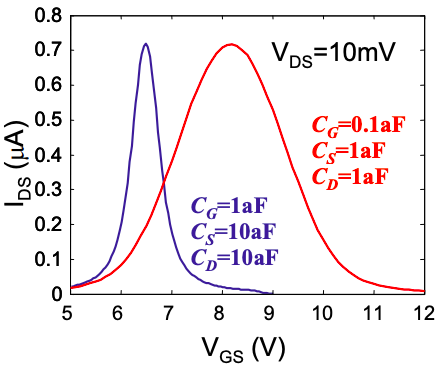5.3: FET Calculations
- Page ID
- 51320
Unlike the two terminal case, where we arbitrarily set \(E_{F} = 0\) and shifted the Source and Drain potentials under bias, the FET convention fixes the Source electrode at ground. There are two voltage sources: \(V_{GS}\), the gate potential, and \(V_{DS}\), the drain potential. We analyze the influence of \(V_{GS}\) and \(V_{DS}\) on the molecular potential using capacitive dividers and superposition:

\[ U_{E S}=-q V_{G S} \frac{1 /\left(C_{D}+C_{S}\right)}{1 /\left(C_{D}+C_{S}\right)+1 / C_{G}}-q V_{D S} \frac{1 /\left(C_{G}+C_{S}\right)}{1 /\left(C_{G}+C_{S}\right)+1 / C_{D}} \nonumber \]
Simplifying, and noting that the total capacitance at the molecule is \(C_{ES} = C_{S} + C_{D} + C_{G}\):
\[ U_{ES} = -qV_{GS}\frac{C_{G}}{C_{ES}}-qV_{DS} \frac{C_{D}}{C_{ES}} \nonumber \]
We also must consider charging. As before,
\[ U_{C} = -\frac{q^{2}}{C_{ES}}(N-N_{0}) \nonumber \]
Recall that charging opposes shifts in the potential due to \(V_{GS}\) or \(V_{DS}\). Thus, if charging is significant, the switching voltage increases; see Figure 5.3.2.

Adding the static potential due to \(V_{DS}\) and \(V_{GS}\) gives, the potential U in terms of the charge, N, and bias.
\[ U=-qV_{GS} \frac{C_{G}}{C_{ES}}-qV_{DS}\frac{C_{D}}{C_{ES}}+\frac{q^{2}}{C_{ES}}(N-N_{0}) \nonumber \]
We also have an expression for potential for N in terms of U (see Equation (3.7.8))
\[ N = \int^{\infty}_{-\infty} g(E-U) \frac{\tau_{D}f(E,\mu_{S})+\tau_{S}f(E, \mu_{D})}{\tau_{S}+\tau_{D}} dE \nonumber \]
As before, Equations (5.3.4) and (5.3.5) must typically be solved iteratively to obtain U. Then we can solve for the current using:
\[ I = q\int^{\infty}_{-\infty} g(E-U)\frac{1}{\tau_{S}+\tau_{D}} \left(f(E,\mu_{S})-f(E,\mu_{D})\right)dE \nonumber \]


